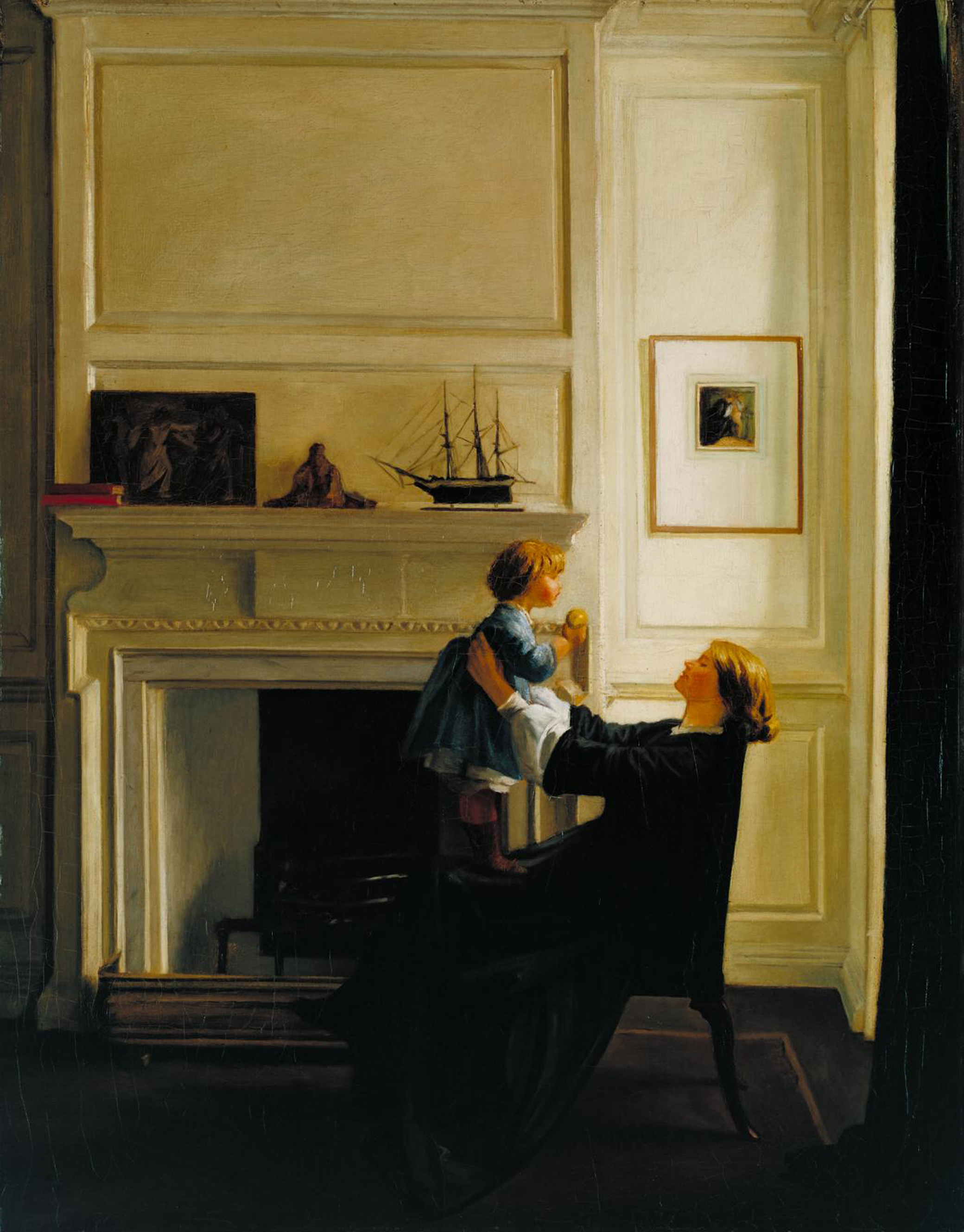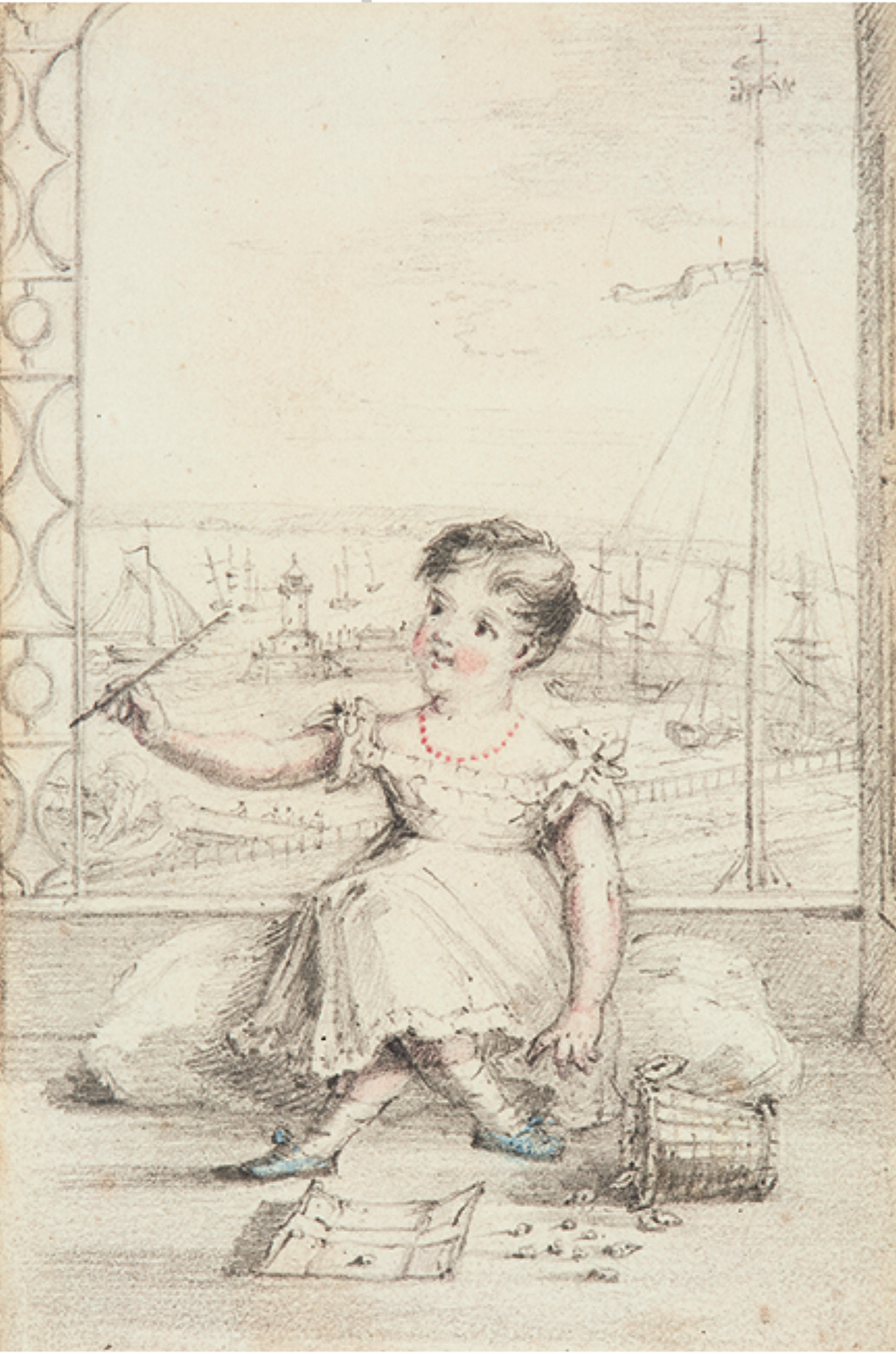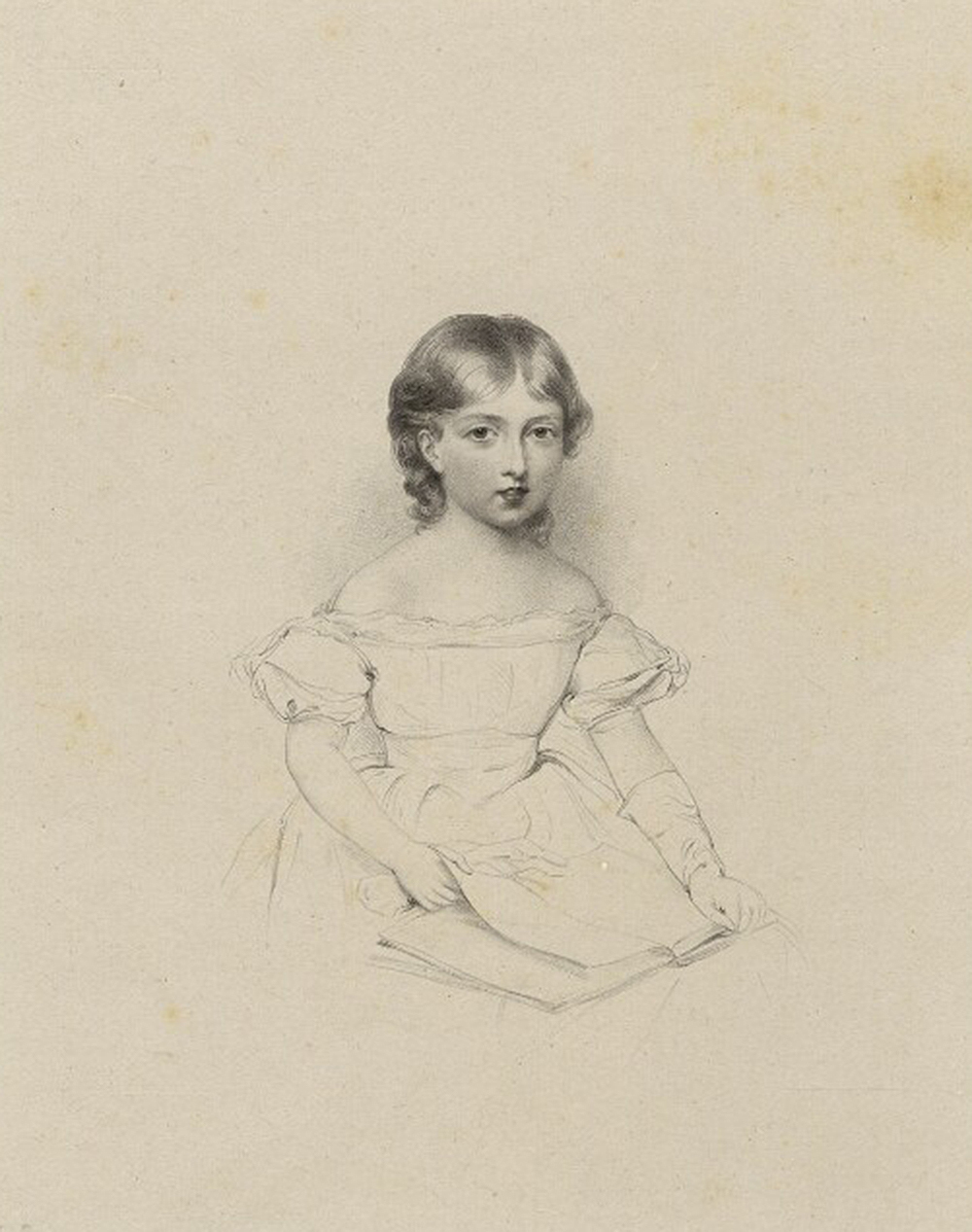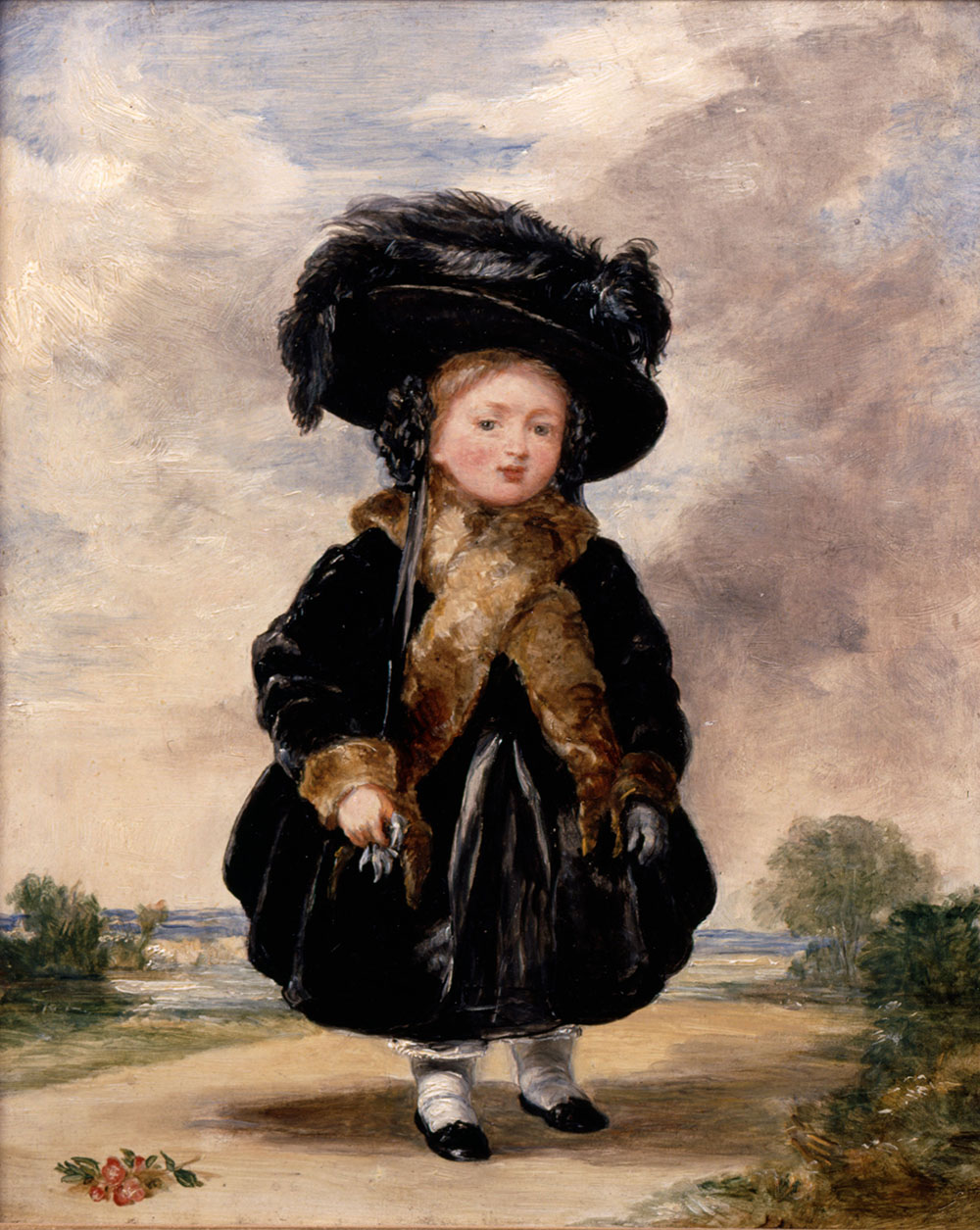
Mother and Child, by Sir William Rothenstein, 1903. Photograph © Tate (CC-BY-NC-ND 3.0).
The infant Victoria may have held some public interest after the death of the Duke of Kent in 1820, but she was still a considerable distance from the throne. George IV was now king and her uncle Frederick, Duke of York, was next in the line of succession. Frederick’s brother William, Duke of Clarence, and his wife Adelaide (with whom the Duke and Duchess of Kent had shared their double wedding at Kew) were next. It was still perfectly possible that they would have more children: Adelaide was only in her late twenties and had many childbearing years ahead of her—and the Duke of Clarence had fathered ten illegitimate children with his mistress Mrs. Jordan—so it seemed likely that they would produce an heir. Still, although she was only third in the line of succession, Victoria was the only legitimate child of her generation, so for the moment there was a possibility—however distant—that she would one day be queen.
The little princess was principally under the care of her nurse, Mrs. Brock, whom she called “Boppy,” until the age of five. The duchess had begun to turn her attention to her younger daughter’s education in 1823. Her chaplain, the Reverend George Davys, a liberal evangelical clergyman and fellow of Christ’s College, Cambridge, was appointed principal master. He had been introduced to the duchess by Conroy and had spent some time helping her improve her English. A mild, patient, and kind man, he was an ideal foil to the spirited young princess, whom he attended for the first time on April 1823. When she arrived for her first lessons, Victoria found a note from her mother waiting for her on the schoolroom table:
My dear little Girl,
I hope you will be very attentive in your repetition and think with what great pleasure it gives to your Mamma to witness your progress in learning and good behavior. God bless you, dearest child.
Ever your very affectionate Mother,
Victoria
The duchess was so anxious for her daughter to perform well with her new master that she evidently resorted to bribery, as Reverend Davys recorded in his journal. He noted, however, that “the Princess asked for the reward before she began the lesson.” Perhaps as an attempt to encourage her, John Conroy gave the princess her first writing desk in 1823. It is a small rosewood, brass, and leather slope with hidden compartments for holding letters and paper, and features a tiny inkwell with a silver top and an ivory quill decorated with a small black “V” for its royal owner.

Princess Victoria did not immediately heed her mother’s words or Conroy’s encouragement. “Her first lesson,” wrote Davys, “was the alphabet, which the princess had learned before. Then the following line, b-a, b-e, b-I, b-o, b-u, b-y, which we did not quite conquer.” Reverend Davys eventually wrote words on cards, which he asked Victoria to bring to him from the other side of the room. The tutor’s principal task was to ensure that his charge spoke perfect English without accent, which was a particular concern of her mother, given the duchess’ own struggles with the language. Davys soon reported that Victoria had a beautiful voice and a flawless accent, although he admitted that she had developed the German habit of sighing and exclaiming “So!” pronounced “Zo!”
Although Victoria inevitably picked up some elements of her mother’s language, she was not taught German until the age of seven and never fully mastered the language. As queen she would write love letters to her husband Albert in German, knowing that it pleased him, but would often revert to English halfway through. Victoria had the short attention span of any child her age. Just after her fourth birthday Reverend Davys wrote that she “improves in reading, but is still not fond of keeping her eyes long together on the book.”
Following a joint lesson for Victoria and her half sister Feodore, he announced: “The little Princess improves in attention. She attended well for an hour.” He reported that she was “quick of comprehension and takes an interest in everything she reads,” but that she did not pay enough attention to master difficulties. She was still less than six years old, he added, noting: “I have endeavored to teach the Princess a little arithmetic. She can now read with tolerable facility.”
To encourage the latter skill Reverend Davys had placed cards with nouns printed on them next to the relevant objects around the room in which her lessons took place. His journal of the years he spent teaching Victoria was later published, and reveals the effort and care that he applied to the task.
In 1824 Louise Lehzen was appointed governess to Princess Victoria. The daughter of a village clergyman from Lagenhagen, near Hanover, Lehzen was forty when she took up her new position. She had previously been governess to Princess Feodore, and had traveled with her to England five years earlier. A rather stern woman, she was nevertheless devoted to her new charge. “She never for the thirteen years she was governess to Pss. Victoria once left her,” Queen Victoria herself later recalled. “The Princess was her only object and her only thought. She was very strict and the Pss. had great respect and even awe of her but with that the greatest affection.”
Lehzen was a calming force to a child whose mood swings could be as violent as her temper. The princess’ willful nature had been evident from an early age. In January 1820 her mother had written to her friend Pauline von Tubeuf that her eight-month-old daughter was “a greater darling than ever, but…beginning to show symptoms of wanting to get her own little way.” Victoria was a prime example of a petted, spoiled, and naughty youngest child, whose behavior contrasted sharply with that of her elder siblings, Feodore in particular. That Victoria herself was aware of this is hinted at in an undated letter that she wrote to her mother on Feodore’s birthday: “I am very anxious to be your comfort like dear Feodore.”

Yet Victoria’s behavior had not been entirely unchecked. In the same letter that her mother had written when her daughter was eight months old, she expressed her determination to curb the princess’ wayward behavior: “I am already beginning to train her, which I am sure you will think wise!” The duchess was heavily influenced by Elizabeth Appleton’s manual Early Education; or, The Management of Children Considered with a View to Their Future Character. The second edition was published in 1821 and was dedicated to the Duchess of Kent.
Nevertheless, the author made it clear that her system applied to children of all classes and that she had written the book “not so much with a view to the forming of their characters to greatness, as to goodness; to accomplishment as to virtue; and is, in consequence, fitted equally to the inferior ranks, as to the most exalted personages of the empire.” There were three guiding principles to Appleton’s approach:
1) Regulating the passions
2) Securing morality
3) Establishing a sound religion
Victoria soon became aware of the high standards that her mother expected of her and, for all her willfulness, was desperate to win her approval. The first surviving letter she wrote to the duchess, dated 1825, was as endearing as it was brief:
Dear Mamma
I love you
Victoria
Yet as the princess herself acknowledged, she consistently fell short of her mother’s expectations. In part this was due to her spirited nature, which could be constrained but never entirely suppressed. In part, too, it was due to the duchess’ indulgence of her younger daughter, which in the end was a stronger impulse than her desire to raise her as an example of Miss Appleton’s model child. As a result, by the time Lehzen took charge the die was cast, as Victoria herself reflected: “Up to my fifth year I had been very much indulged by everyone, and set pretty well all at defiance.”
Nevertheless, the new governess applied all her efforts to correcting the damage. She read stories to Victoria in order to stop her chattering to servants, tried to teach the princess to write and read aloud to her every day while she had her hair done not from novels but from educational texts such as the letters of Madame de Sevigné and Irish history. The governess was undaunted by her charge’s frequent rages, even when Victoria threw a pair of scissors at her. From the beginning, her governess was present whenever Victoria went for a walk or carriage ride, and from 1827 she attended all her lessons. But for all her governess’ efforts, the princess’ volatility remained a source of concern, so in 1831 Lehzen decided to introduce a “behavior book.” Responsibility for completing this was given to Victoria, who was obliged to record her conduct every morning and afternoon. On November 3 she was “very thoughtless”; two days later she was “very naughty.” By the end of the week she was mainly good, although momentarily “very impertinent.” Other entries make it clear that the governess was often at the receiving end of her charge’s temper. On the morning of October 31 she had been “rather impertinent to Lehzen,” “very ill-behaved and impertinent to Lehzen” the following morning, and “naughty and vulgar” that afternoon. Although the princess’ behavior is more often described as “good,” there are some instances of explosive tantrums, such as on the morning of August 21, 1832 during a visit to Beaumaris Castle in Wales, when she was obliged to record that she was “very very very terribly naughty,” underlining the “very”s three times and the “naughty” four. Another such incident flared up the following month, when on the afternoon of September 14, the princess noted that she was “very very very very horribly naughty!!!!!” underlining each word four times.
Lehzen’s unstinting efforts and unwavering devotion would become the benchmark by which Victoria would measure all her companions throughout her long life. “She had devoted her life to me, from my fifth to my eighteenth year, with the most wonderful self-abnegation, never even taking one day’s leave!” she later recalled. “I adored her, though I also feared her.” The servant-mistress relationship soon became so embedded in her young mind that it was one she would replicate time and again, even with her husband, Albert. Although Victoria would sometimes express the same awe that she felt towards Lehzen, she would also make those close to her suffer the same outbursts of temper as her governess endured on numerous occasions.

The queen’s later recollection that she was “not fond of learning as a child—and baffled every attempt to teach me any letters up to five years old” has caused most biographers to insist that she disliked learning. But this was clearly not the case. The story of “little An,” which she wrote at Ramsgate in 1827, must have been the source of much amusement. Her heroine was “naughty greedy and disobedient.” Another story told of Harriet, one of two sisters, who received a gift of a “pretty white poudel.” In a series of early writing practice books, she repeated words that would be meaningful to her. In the first, the word commoner appears several times. Another is inscribed: “Aunt, Windsor, mantua, bullion, Germany and ominous.” These practice books were later filled with place names, such as Oxford, Rochester in Kent, Paris, Narbonne, Valenciennes (which Victoria noted was “famous for lace, in the Netherlands”), and Ostend, a seaport in Belgium.
Victoria’s early texts included The History of the Tame Robin, a book of German fables, Chronology of the Kings of England, and A Visit to the Elephant, a small book given to the princess by her mother on her birthday in 1826. She had no idea yet what lay ahead for her in terms of the succession, but some of these texts can be read as a warning. “My dearest Lehzen. I have been reading a very interesting account of Mary of Scots. Mary was the daughter and only child of James the 5th of Scotland…”
In a later book, Queen Anne “was good-natured but weak & easily governed by favorites,” and in another, Elizabeth I was “a great queen but a bad woman and even in her regal capacity she erred sometimes; she had a very great idea of her prerogative and was more arbitrary even than her tyrannical father.” Victoria’s antipathy toward the last Tudor queen may have stemmed from criticism during her childhood that her own name was “un-English” and that she should change it to Elizabeth.
From The Young Victoria by Deirdre Murphy, published by Yale University Press in association with Historic Royal Palaces in May 2019. Reproduced by permission.
